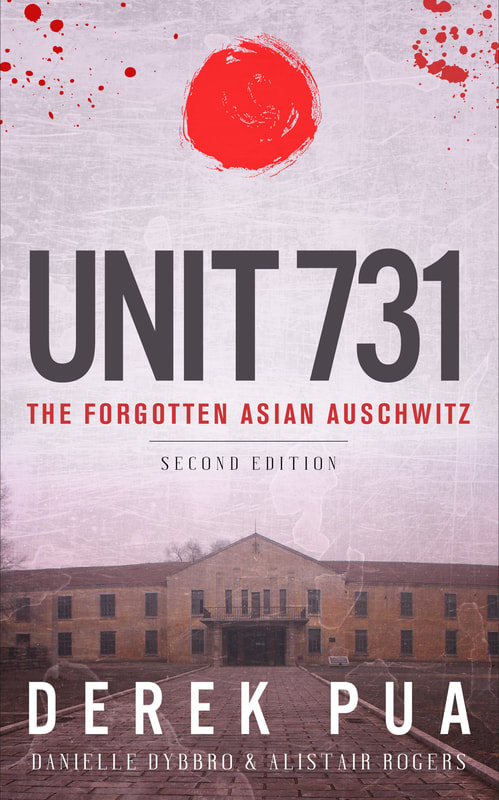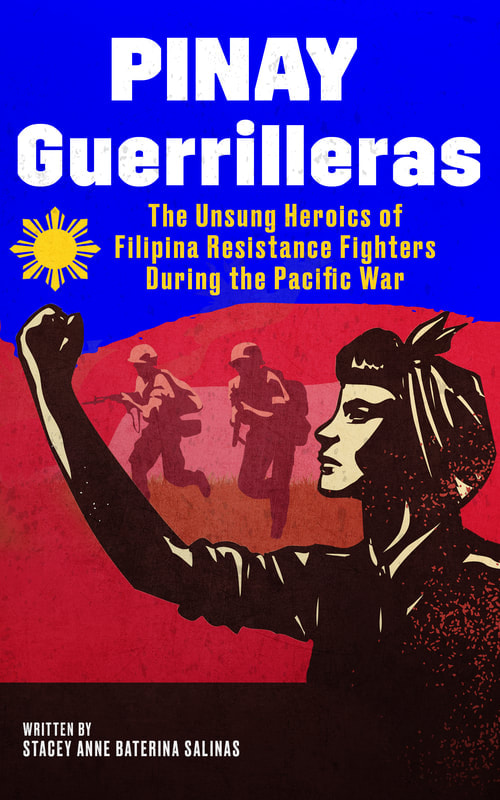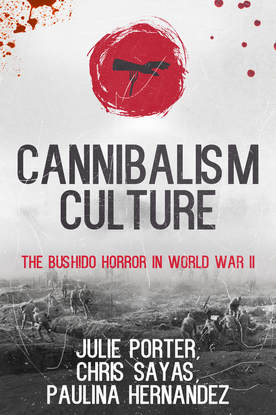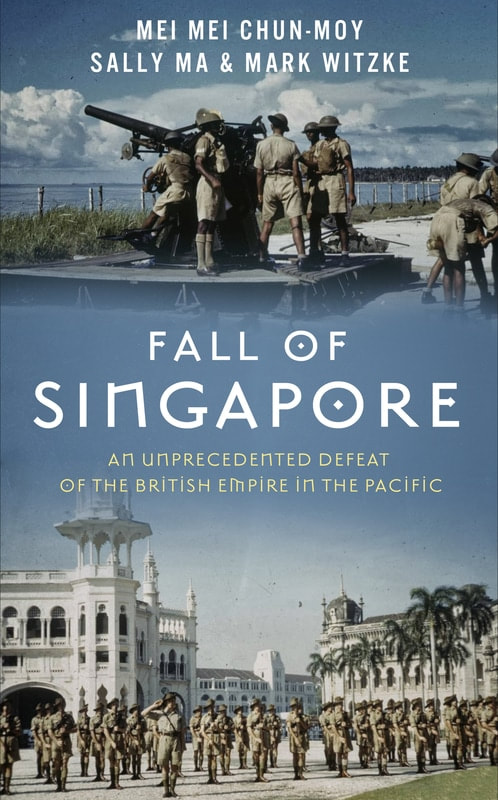- Home
- Stories
-
Internship
- Summer 2024 Internship
- Summer 2023 Internship
- Fall 2022 Internship
- Summer 2022 Internship
- Summer 2021 Internship
- Fall 2020- Spring 2021 Internship
- Summer 2020 Internship
- Fall 2019 Internship
- Summer 2019 Internship >
- School Year 2018-2019 Internship
- Summer 2018 Internship >
- Fall 2017 Internship
- Summer 2017 Internship >
- Books
- Archives
-
Resource Page
-
Supplementary Research Guides
>
- Unit 731 - Guide >
-
Philippines' Resistance - Guide
>
- Philippines World War II Timeline
- The Japanese Invasion & Conquest of the Philippines
- Bataan Death March
- Formation of Underground Philippines Resistance
- Supplies of the Guerrilla Fighters
- The Hukbalahap
- Hunter's ROTC
- Marking's Guerrillas
- United States Army Forces in the Philippines of Northern Luzon (USAFIP-NL)
- The Aetas
- Chinese and Filipino-Chinese Nationalist Guerrilla Units
- The Female Faces of the Philippine Guerrillas
- Rising Sun Flag - Guide >
- Pinay Guerrilleras - Guide >
- Fall of Singapore - Guide >
- Three Years and Eight Months - Guide >
- Siamese Sovereignty - Guide >
- The Khabarovsk War Crimes Trial - Guide >
- Unit 731 Cover-up : The Operation Paperclip of the East - Guide >
- Marutas of Unit 731 - Guide >
- Prince Konoe Memoir - Guide >
- Competing Empires in Burma - Guide >
- Battle of Shanghai - Guide >
- Ishi Shiro - Guide >
- Taiwan The Israel of the East - Guide >
- Seeking Justice for Biological Warfare Victims of Unit 731 - Guide >
- Rice and Revolution - Guide >
- Clash of Empires - Guide >
-
Hunger for Power and Self-SufficiencyI - Guide
>
- The Influence of War Rations on Post-War Culinary Transformations
- How World War II Complicated Food Scarcity and Invention
- American Military Innovations
- Government-Sponsored Food Inventions in Europe during World War II
- Feeding the Army: The Adaptation of Japanese Military Cuisine and Its Impact on the Philippines
- Mixed Dishes: Culinary Innovations Driven by Necessity and Food Scarcity
-
Denial A Quick Look of History of Comfort Women and Present Days’ Complication - Guide
>
- The Comfort Women System and the Fight for Recognition
- The Role of Activism and International Pressure
- The Controversy over Japanese History Textbooks
- The Sonyŏsang Statue and the Symbolism of Public Memorials
- Activism and Support from Japanese Citizens
- The Future of Comfort Women Memorials and Education
- Echoes of Empire: The Power of Japanese Propaganda - Guide >
- Lesson Plans >
-
Supplementary Research Guides
>
|
Under the leadership of Dr. Shiro Isshi, Unit 731 subjected 3,000-250,000 innocent men, women, and children to cruel experiments and medical procedures that were carried out by the brightest medical students and staff that Imperial Japan had to offer.
In a bid to develop its own germ warfare capability, the government of Imperial Japan resorted to incredibly deprived and inhumane methods of experimentation, like infecting prisoners with virulent strains of anthrax, plague, cholera, and other diseases. These prisoners were often subject to excruciating vivisections without the use of anesthesia in order to observe the real-time effects of these deadly diseases. Perhaps the most shocking development after the war was that the perpetrators of this heinous crime against humanity have largely escaped persecution unlike their Nazi counterparts in Europe. In a cowardly attempt to escape persecution by the Soviets, Dr. Shiro Isshi and his staff were able to trade the information obtained from their experiments with the Americans in return for immunity in the Tokyo Trials. Available in Ebook and Audiobook format. |
|
December 8th, 1941 marked the start of the full-scale invasion of the Philippines. With the surrender of the Bataan Peninsula and the fortified island Corregidor in the Spring of 1942, all hope seemed lost. But, almost overnight, the Philippine underground resistance began to take shape. Units made up of guerrilla volunteers from all walks of life participated in the liberation of the Philippines. The women guerrillas of the resistance, or guerrilleras, are one such group who have received less attention in Pacific Theater histories. The names and faces of those Filipina guerrilla soldiers, who led their own units, conducted espionage, nursed the wounded, led raids, or raised armies, have nearly been forgotten. The rigid gender barriers guerrilleras faced both on and off the field of duty resulted in their stories being silenced or relegated to less commanding roles in the aftermath of the war. This book attempts to bring these stories to light so that the legacy of these unsung Filipina resistance fighters lives on.
|
|
The Second World War is regarded as one of the most brutal conflicts of the modern era. This book investigates what war can do to one's identity, character, and culture. The Imperial Japanese soldiers from New Guinea, Chichijima, and other Asia Pacific Islands, ate the flesh of prisoners of war and slave laborers, sometimes stripping the meat from live men. Who is to blame? Are the Japanese soldiers from different units and locations to blame. Was it Japan's rise, it's aggression and violent expansion, from the Russo-Japanese War and the Pacific Asia War that led to this uncharacteristic behavior. Or was the problem with the unending volume of propaganda, from nationalism to religion and emperor worship. Or was it isolation, fear, lack of food, that caused them to become cannibals. The book "Cannibalism Culture - The Bushido Horror in World War II", uncovers the hidden causes of horror in war.
|
|
The people of the Philippine Islands during the early half of the twentieth century experienced various waves of Western Imperialism, two wars of attempted secession from western powers, and two world wars. And yet, the Philippine Islands and its people have received only small subheadings in many American textbooks and histories. The wartime experiences from the perspectives of the Philippine people have gone unnoticed and have become overshadowed by the socio-political dominating legacy of American figures like General MacArthur, leader and historical symbol of the Pacific Theater during World War II. MacArthur’s famous phrase “I came through and shall return” are etched into every facet of World War II historical narratives, textbooks, and monuments that pay tribute to the Allied forces in the retaking of the Pacific from the Japanese. But It is the lesser known people and leaders of the Philippine resistance against the Axis powers whose efforts and contributions allowed for the effective and speedy return of MacArthur’s military forces.
The Philippine guerrilla resistance consisted of a diverse cast of Filipino men and women, ethnic and indigenous minorities, American and European immigrants and soldiers, young and old, rich and poor, from farmer to politician. The various units of Philippine guerrillas, their tactics, military resources, and vigor to survive and end the Japanese maltreatment of the Philippine peoples paint the Pacific Theater from 1941-1945 as desperate, dark, and bloody for Asian communities throughout East and Southeast Asia. But their resourcefulness, cooperative efforts to collaborate and network with MacArthur across the South Pacific, and their massive grassroots liberation movement directly point to the remarkable value that the Philippine Underground Resistance proved to be in aiding the Allies’ ability to retake the Pacific. For four years, Filipino guerrillas faced battles and scenarios on over fifteen islands that make up the 7000 islands of the Philippine Archipelago where the odds of having both military strength and resources were not in their favor. But with unrelenting hardiness and hope to end the Japanese occupation, the Filipino guerrillas from island to island weakened the military presence of the Japanese throughout the Philippine Islands making the Philippines the last Allied stronghold of the Pacific. |
|
The occupational period by the Imperial Japanese Army in WWII is Hong Kong’s darkest chapter in history, colloquially known as the “Three Years and Eight Months” period amongst veterans and survivors. However, the lack of contemporary interests towards this subject by historians has led to a limited amount of academic works on the subject being published. This lack of written works, coupled with the declining population of veterans and survivors, has already resulted in the memory of the war to be neglected amongst Hong Kong’s youth, almost forgotten.
|
|
The flag of the Rising Sun was first originally used throughout feudal Japan and during the Meiji Reformation officially became a battle flag for the new imperial military.
During the Second World War and well before, the Empire of Japan used the Rising Sun flag for not just state use or functions but also naval jacks and army banners, cementing its image as a symbol for an aggressive and imperialist Japan. To many Koreans, Filipinos, Chinese, and countless Asian ethnicities, the Rising Sun Flag occupied the same moral space as the swastika and the Nazi flag. Yet although Japan was also an Axis power responsible for heinous war crimes, Japan did not seem to go through the same deep cultural cleansing of its official and state symbols the way that Germany was following the end of the war. The flag did not receive an official ban from the government nor from the allied occupation forces. The Rising Sun, although a symbol of the Japanese Empire would see its official return again in 1954 when the Japan Self Defense Forces were officially founded following Soviet military and nuclear threats. Less than a decade earlier it had been used for militaristic and imperialist motivations by an aggressive government seeking to build an empire and enrich itself by any means necessary. To many throughout the Asian continent, the Rising Sun symbolizes hostility and serving unwillingly to an empire. To many, it also brings images of comfort women, the Rape of Nanking, and the brutality of a warmongering military. |
|
The fall of Singapore is the greatest defeat of the British empire in the Pacific.
On February 15, 1942, the British surrendered to the Imperial Japanese Army and handed over Singapore and surrounding Malaya countries. The conflict began on December 8, 1941 when Japanese forces bombed Singapore and continued to make their way through the treacherous Malayan jungle. British Prime Minister Winston Churchill stated during the attack, “the worst disaster and the largest capitulation in British history”. Singaporeans were immediately ordered to come in for questioning after the Imperial Japanese Army took over. During the interview, their homes were looted and destroyed by the Kempeitai, the secret Japanese police. During the occupation, there were many tragedies. An example is the Sook Ching Massacre. Sook Ching Massacre, literally meaning “purge through cleansing”, began on February 21, 1942. The mass murder of Singapore residents ages 18 to 50, was targeted at eradicating anti-Japanese sentiments. Victims of the massacre were either Chinese, suspected of being pro-Chinese, anti-Japanese, or Communist. Men and women were questioned and if found guilty, they were taken to one of Singapore’s beaches and murdered. The death toll shows less than 5,000 according to the official Japanese record, while Singaporean officials claim the number of victims was at least 50,000. |
|
Pacific Atrocities Education
730 Commercial Street San Francisco, CA 94108 415-988-9889 |
Copyright © 2021 Pacific Atrocities Education.
We are a registered 501 (c)(3) charity. |
- Home
- Stories
-
Internship
- Summer 2024 Internship
- Summer 2023 Internship
- Fall 2022 Internship
- Summer 2022 Internship
- Summer 2021 Internship
- Fall 2020- Spring 2021 Internship
- Summer 2020 Internship
- Fall 2019 Internship
- Summer 2019 Internship >
- School Year 2018-2019 Internship
- Summer 2018 Internship >
- Fall 2017 Internship
- Summer 2017 Internship >
- Books
- Archives
-
Resource Page
-
Supplementary Research Guides
>
- Unit 731 - Guide >
-
Philippines' Resistance - Guide
>
- Philippines World War II Timeline
- The Japanese Invasion & Conquest of the Philippines
- Bataan Death March
- Formation of Underground Philippines Resistance
- Supplies of the Guerrilla Fighters
- The Hukbalahap
- Hunter's ROTC
- Marking's Guerrillas
- United States Army Forces in the Philippines of Northern Luzon (USAFIP-NL)
- The Aetas
- Chinese and Filipino-Chinese Nationalist Guerrilla Units
- The Female Faces of the Philippine Guerrillas
- Rising Sun Flag - Guide >
- Pinay Guerrilleras - Guide >
- Fall of Singapore - Guide >
- Three Years and Eight Months - Guide >
- Siamese Sovereignty - Guide >
- The Khabarovsk War Crimes Trial - Guide >
- Unit 731 Cover-up : The Operation Paperclip of the East - Guide >
- Marutas of Unit 731 - Guide >
- Prince Konoe Memoir - Guide >
- Competing Empires in Burma - Guide >
- Battle of Shanghai - Guide >
- Ishi Shiro - Guide >
- Taiwan The Israel of the East - Guide >
- Seeking Justice for Biological Warfare Victims of Unit 731 - Guide >
- Rice and Revolution - Guide >
- Clash of Empires - Guide >
-
Hunger for Power and Self-SufficiencyI - Guide
>
- The Influence of War Rations on Post-War Culinary Transformations
- How World War II Complicated Food Scarcity and Invention
- American Military Innovations
- Government-Sponsored Food Inventions in Europe during World War II
- Feeding the Army: The Adaptation of Japanese Military Cuisine and Its Impact on the Philippines
- Mixed Dishes: Culinary Innovations Driven by Necessity and Food Scarcity
-
Denial A Quick Look of History of Comfort Women and Present Days’ Complication - Guide
>
- The Comfort Women System and the Fight for Recognition
- The Role of Activism and International Pressure
- The Controversy over Japanese History Textbooks
- The Sonyŏsang Statue and the Symbolism of Public Memorials
- Activism and Support from Japanese Citizens
- The Future of Comfort Women Memorials and Education
- Echoes of Empire: The Power of Japanese Propaganda - Guide >
- Lesson Plans >
-
Supplementary Research Guides
>







